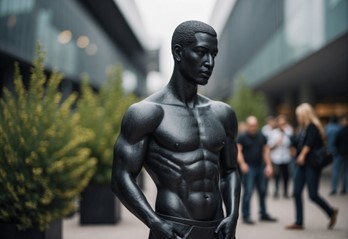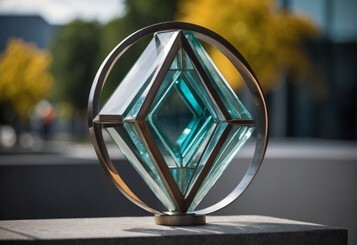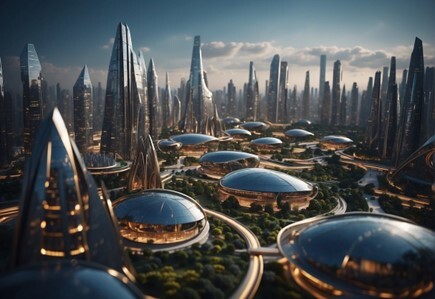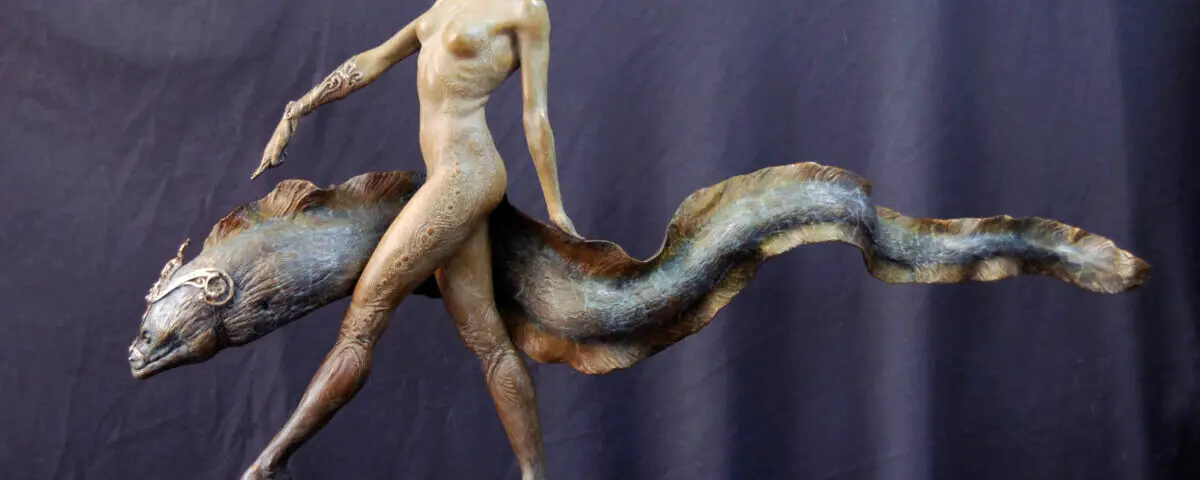|
Getting your Trinity Audio player ready...
|
Modern sculpture is a dynamic and diverse art form that has significantly impacted on the art world. It encompasses wide ranging styles, techniques, and materials, which reflect an ever-changing artistic landscape.
First there were revolutionary movements:
- Art Nouveau and
- Cubism.
Then came innovative approaches of:
- Minimalism and
- Conceptual art.
They all ensured modern sculpture would evolve and challenge traditional boundaries and redefine artistic expression.
The historical context of modern sculpture is deeply rooted in the 19th and 20th centuries. It departs from classical forms and shifts towards abstraction and experimentation. Pablo Picasso, Henry Moore, and Barbara Hepworth played pivotal roles in shaping the trajectory of modern sculpture.
As you will read in this article, they pushed the boundaries of traditional artistic norms and paved the way for future generations of sculptors.

- Key Takeaways
- Modern sculpture encompasses a wide range of styles, techniques, and materials, reflecting an ever-changing artistic landscape.
- The historical context of modern sculpture is deeply rooted in the 19th and 20th centuries.
- There was a departure from classical forms and a shift towards abstraction and experimentation.
Modern and Contemporary Sculpture: Historical Context
The term Modern Sculpture describes a diverse and constantly evolving art form that has evolved from the late 19th century to the present day. And it has been shaped by a range of artistic movements, historical events, and cultural influences.
This section explores the historical context of modern sculpture. In it we highlight key developments and movements that have shaped the art form.
Early Modern Sculpture
Modern sculpture emerged in the late 19th century as a response to the changing social, political, and cultural landscape of Europe. The period was marked by:
- rapid industrialisation,
- urbanisation, and
- the rise of new technologies.
These changes had a profound impact on the art world, leading to the development of new artistic movements such as:
- Art Nouveau,
- Cubism, and
- Futurism.
Early modern sculptor, Auguste Rodin, challenged traditional sculptural conventions. He emphasised the expressive potential of the human form. And his innovative approach to sculpture paved the way for other modernist sculptors, including Constantin Brancusi and Henry Moore.
Mid-20th Century Developments
The middle of the 20th century was a period of significant development for modern sculpture. New artistic movements such as Abstract Expressionism, Minimalism, and Pop Art emerged. And they challenged traditional notions of sculpture by emphasising abstraction, simplicity, and mass production.
An influential mid-20th century sculptor was Alexander Calder. His work, which included large-scale mobiles and stabiles, explored the relationship between form, space, and movement. Other notable mid-20th century sculptors were Louise Bourgeois, Barbara Hepworth, and Isamu Noguchi. They were followed by modern day sculptors Anish Kapoor, Jeff Koons, and Damien Hirst.
Late 20th Century to Present
The late 20th century to the present day has been marked by a range of artistic movements and developments in modern sculpture. They included the rise of:
- installation art,
- land art, and
- conceptual art.
These movements challenged traditional notions of sculpture, emphasising the importance of site-specificity, interactivity, and conceptualisation.
Modern sculpture has evolved through historical, cultural, and artistic influences. Sculptors, from the early modern period to today, have questioned traditional ideas and experimented with new forms, materials, and concepts.
A good example is Richard Serra’s large-scale, site-specific sculptures which challenge the viewer’s perception of space and time.
Styles and Movements in Modern Art
The 20th century movements were characterised by a desire to break away from traditional forms of representation and explore new forms of expression. In this section we explore some of the most important styles and movements in modern sculpture.
Cubism and Abstract Sculpture
Cubism emerged in the early 20th century using geometric shapes and fragmented forms to create abstract compositions. Cubist sculptures depicted everyday objects, such as bottles and guitars, in a highly stylised and abstracted form.
Abstract sculpture emerged in the 1910s and 1920s. It used non-representational forms, rejecting traditional figurative sculpture. Abstract sculptures sought to explore the relationship between form and space, creating a sense of movement and energy.
Minimalism and Conceptual Art
Minimalism emerged in the 1960s. It focused on simple, geometric forms, rejecting traditional material and techniques. Minimalist sculptures consisted of industrial materials, such as steel and concrete, designed to create a sense of purity and simplicity.
Conceptual art emerged in the 1960s and 1970s, and focused on ideas and concepts, rather than traditional forms of artistic expression. Conceptual sculptures consisted of everyday objects, such as chairs and tables, which artists transformed into works of art by conceptual intervention.
Pop Art and Surrealism
Pop Art in the 1950s and 1960s focused on popular culture and consumerism. And it often incorporated images from advertising and mass media. Pop sculptures critiqued the commercialisation of art and challenged traditional notions of artistic value.
Surrealism, on the other hand, which emerged in the 1920s, focused on the subconscious and the irrational. It often incorporated dreamlike imagery and symbolism. Surrealist sculptures challenge conventional ideas about the nature of reality and explore the hidden depths of the human psyche.

Takeaway
Modern sculpture includes styles and movements with unique characteristics and artistic visions. From Cubism’s geometric forms to Conceptual Art’s conceptual interventions, it constantly pushes artistic boundaries and challenges our perceptions of the world.
Types of modern sculpture
The types of modern sculpture include:
- Kinetic sculpture: Sculptures that move, either using motors or by manual means.
- Assemblage sculpture: Sculptures made from found objects and materials.
- Installation sculpture: Sculptures that are created to be installed in a specific location.
- Environmental sculpture: Sculptures that are created to blend in with the environment.
Materials and Techniques in Sculpture

Sculpture is a form of art that involves the creation of three-dimensional objects. Sculptors use a wide range of materials and techniques to bring their ideas to life. In this section, we discuss traditional and innovative materials and sculpting methods used in modern sculpture.
Traditionally, sculptors used materials such as wood, marble, clay, and metals. However, modern sculptors use any material the artist wishes, including plastic and even found objects. Lights, projections, music, and other technologies may be used to enhance their work.
Traditional Materials
Bronze, marble, and plaster are traditional materials used in sculpture.
- Bronze: is popular in outdoor sculptures due to its durability and resistance to corrosion.
- Marble: is softer and allows the artist to create intricate details. It is often used in figurative sculptures.
- Plaster: is a versatile material that can be molded easily and is commonly used for creating molds to cast sculptures.
Innovative Mediums
In addition to traditional materials, modern sculptors use innovative mediums such as metal. Metal sculpture involves the use of steel, aluminum, and copper. These materials offer a range of unique properties such as strength, malleability, and colour. Other materials used which have differing properties are:
- glass,
- wood, and
- plastic.
Sculpting Methods
Sculptors use a variety of techniques to create their works. The most common methods include carving, modeling, and casting.
- Carving involves removing material from a block (e.g. stone or wood) to create a sculpture.
- Modeling is a process of building up material, such as clay, to create a sculpture, while
- Casting involves making a mold of an object and then pouring molten metal, such as bronze, into the mold to create a sculpture.

- Takeaways
- Modern sculpture encompasses a wide range of materials and techniques.
- Sculptors are constantly experimenting with new materials and methods.
- Modern sculpture offers a diverse and exciting range of artistic expression.
Artists and Sculptors who Impacted Modern Sculpture
Pioneers of Modern Sculpture
The Modern Sculpture movement that began in the late 19th century continues to evolve today. The pioneers were artists who broke away from traditional methods and techniques, by experimenting with alternative materials and forms.
- Rodin: One of the most influential pioneers of modern sculpture was Auguste Rodin. His works, The Thinker and The Kiss, challenged traditional notions of sculpture and paved the way for future artists.
- Picasso: Another pioneer of modern sculpture was Pablo Picasso. Although best known for painting, Picasso also created sculptures that were groundbreaking in their use of unconventional materials and techniques. His sculptures, such as Bull’s Head and She-Goat, were made from found objects and everyday materials, demonstrating a new approach to sculpture.
- Brancusi: Another pioneer of modern sculpture, Constantin Brancusi, had a significant impact on the movement. His works, Bird in Space and The Kiss, were characterised by simplified forms and abstract shapes. Brancusi’s sculptures were groundbreaking in their rejection of traditional realism and their embrace of abstraction.
Contemporary Masters
The legacy of modern sculpture lives on through the work of contemporary sculptors.
Louise Bourgeois: is considered one of the most influential modern sculptors due to the originality and impact of her work. She was an experimenter fascinated by unusual material others didn’t use in sculpting. Then she challenged tradition and explored controversial themes, such as sexuality, womanhood, and the human psyche.
Alberto Giacometti: another influential contemporary sculptor who had a significant impact on modern sculpture. His works, such as Walking Man and City Square, had elongated forms and rough surfaces. Giacometti’s sculptures were groundbreaking in their exploration of the human form and their rejection of traditional realism.
Other contemporary masters: Henry Moore, Richard Serra, Carl Andre, and Nam June Paik. Each artist has made significant contributions to the movement, by pushing boundaries and inspiring future generations of sculptors.

- Takeaway
- Modern sculpture has been shaped by many artists and sculptors over the past century.
- The pioneers of modern sculpture challenge traditional notions of sculpture.
- Their work has impacted the art world and continues to inspire and influence artists today.
Major Works and Installations
Iconic Modern Sculptures
Modern sculpture has produced several iconic works that have gained worldwide recognition and acclaim. One such example is Banksy’s Girl with Balloon, which has become a cultural phenomenon and a symbol of hope and resilience. Another renowned work is Constantin Brancusi’s Bird in Space, which is considered a masterpiece of modernist sculpture. The sleek and abstract form of the bird in flight has become a symbol of freedom and transcendence.
Public Art and Sculpture Gardens
Public art and sculpture gardens are important aspects of modern sculpture. They provide an opportunity for artists to engage with the public and create works that are accessible to all. The Sculpture Garden at the Museum of Modern Art in New York is a prime example.
It features works by some of the most influential sculptors of the 20th century, including David Smith and Alexander Calder. The National Gallery in London also has a stunning sculpture garden, featuring works by Henry Moore and Barbara Hepworth.
Gallery and Museum Exhibitions
Gallery and museum exhibitions are important platforms for modern sculpture, allowing artists to showcase their works in a curated and controlled environment.
- The Museum of Modern Art (New York): has been at the forefront of promoting modern sculpture. The Shape of Things exhibition explored the evolution of sculpture from the 19th century to the present day.
- The National Gallery (London): has also hosted several exhibitions on modern sculpture, including Sculpture Victorious. It examined the impact of the Victorian era on the development of sculpture.
The Market for Modern Sculpture
Collecting Modern Sculpture
Collecting modern art – sculpture is expensive but has become increasingly popular in recent years. With a plethora of talented artists producing unique and innovative works, there is no shortage of options for collectors. Many collectors are drawn to modern sculpture because of its ability to challenge traditional notions of art and aesthetics.
One important aspect of collecting modern sculpture is determining whether to buy original pieces or limited-edition reproductions. Original pieces are often more expensive, but they offer the added benefit of being one-of-a-kind. Limited edition reproductions, on the other hand, are often more affordable and can be a good option for those who are just starting out in the world of art collecting. When purchasing limited edition reproductions, it is important to look for pieces that are signed and numbered, as this can increase their value over time.
Modern Sculptures for Sale
When buying modern sculptures, platforms like Artsy and Masterworks, showcase pieces by renowned contemporary artists. The artist’s reputation, materials used, and overall aesthetics are covered. Modern sculptures often use unconventional materials like metal and glass, so you should understand the materials before purchasing.
Some modern sculptures come in limited editions, making them highly sought after by collectors. The modern sculpture market is dynamic, with new artists and works constantly emerging. For seasoned collectors or beginners, there are exciting options to add modern sculpture to a collection.
Modern Sculpture: Cultural Impact and Legacy
Sculpture in Public Spaces
Modern sculpture has had a significant impact on public spaces. Sculptures in public spaces have the power to transform the environment in which they stand. They can create a sense of place and identity and can also serve as landmarks and tourist attractions.
Contemporary sculptors have been commissioned to create public art installations in many cities. They range from large-scale sculptures to interactive pieces that engage with the public.
- Angel of the North: One of the most famous examples of modern sculpture in public spaces is the Angel of the North by Antony Gormley. This 20-metre-tall sculpture in Gateshead, England, has become an iconic symbol of the region.
- Cloud Gate: Another example is Anish Kapoor’s Cloud Gate in Chicago, which has become a popular tourist attraction and a symbol of the city.
Influence on Contemporary Art
Modern sculpture has been a big influence on contemporary art. Many contemporary artists have been inspired by the works of modern sculptors and have incorporated elements of modern sculpture into their own work. Modern and contemporary art galleries around the world showcase the works of emerging artists and established contemporary sculptors.
The works of modern sculptors have challenged traditional ideas of what art should be, and have opened up new avenues for artistic expression. The legacy of modern sculpture can be seen in the work of contemporary sculptors.

- Takeaway
- Modern sculpture has had a lasting impact on public spaces and contemporary art.
- The works of modern sculptors have transformed the way we think about sculpture.
- The legacy of modern sculpture continues to shape the art world.
Future Direction for Modern Sculpture
As contemporary art continues to evolve, so does sculpture. The future direction of modern sculpture is likely to be shaped by innovation and technology. And there should be a growing emphasis on sustainability.
Innovation and Technology

Modern sculptors have turned more to new technology to create works. From 3D printing to virtual reality, technology has opened new possibilities for sculpture. And in the latter part of the 20th century, sculptors made use of technology to create interactive sculptures that responded to the viewer’s movements. The trend is likely to continue.
By way of example, the use of augmented reality (AR) allows sculptors to create works that are interactive and responsive to the environment around them. The technology has the potential to revolutionise the way we experience sculpture, blurring the lines between digital and physical worlds.
Sustainability in Sculpture
As we become more environmentally conscious, sustainability of sculpture is likely to become a bigger factor. Sculptures made from sustainable materials such as recycled metal or wood are more common now. As sculptors explore ways to create sustainable works, the trend is likely to continue.
Biodegradable materials such as cornstarch or hemp can be used to create sculptures that will eventually break down and return to the earth. This approach to sculpture is not only environmentally friendly but also encourages a more mindful approach to art.
Final Thoughts
The future of modern sculpture is likely to be shaped by:
- innovation,
- technology, and
- sustainability.
As sculptors continue to explore new possibilities we can expect to see new and exciting works that challenge our perceptions of art in the 21st century.
Modern sculpture has come a long way since its inception in the early 20th century. With its roots in the Modernist movement, contemporary sculpture has evolved into a diverse and vibrant art form that encompasses a wide range of styles and techniques. From abstract and conceptual works to figurative and representational pieces, modern sculpture offers something for every taste and sensibility.
One of the most striking features of modern sculpture is its ability to engage viewers on multiple levels. Whether it’s colour, texture, or form, contemporary sculptors are adept at creating works that challenge our perceptions and stimulate our imagination. Modern sculptors continue to expand our understanding of what art can be.
Contemporary sculpture connects the past and present through diverse historical and cultural influences. Artists draw from ancient traditions like Africa and Asia to modern 21st-century technologies, showcasing the richness of human experience. This dynamic art form, evolving in the 21st century, appeals to both seasoned art lovers and curious newcomers, offering inspiration and capturing imagination.
Why not Join Us
If you enjoyed this article, we would like to offer you two gifts – our Starter Pack of 4 James King’s books and our Weekly Digest, which you can receive by email.

